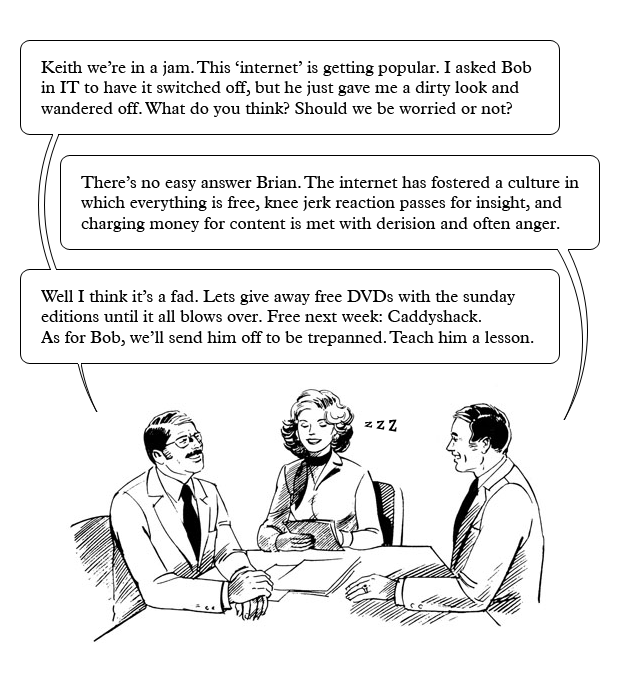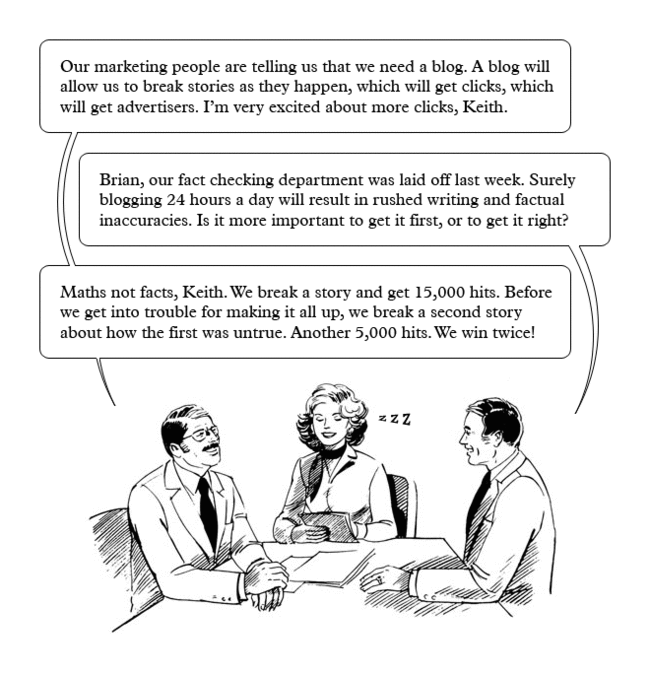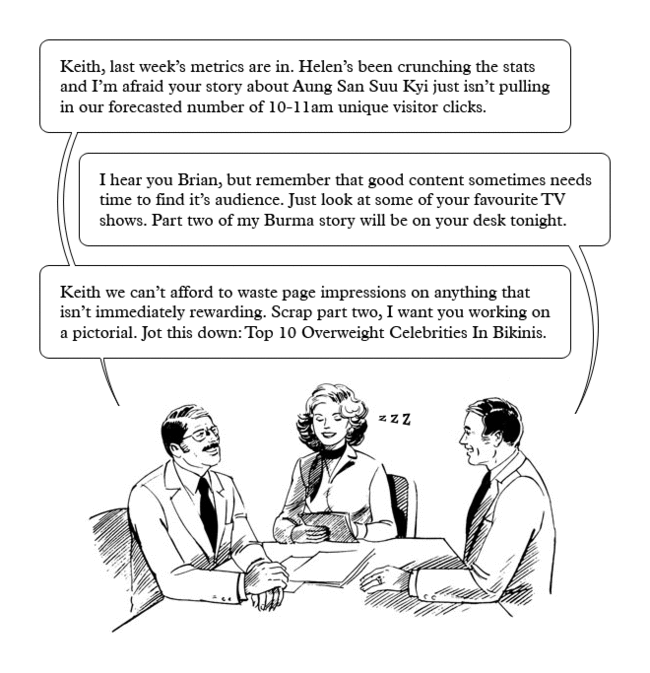Bad News
Foreword: This article was originally written in late 2009. I’ve tidied and reproduced it here partly because I’m still insanely proud of my cartoons, and partly because, well, actually not that much has changed.
One thing I didn’t predict was the rise of more content led, pared back reading experiences such as svbtle and Readability. Still, I hope there’s still some value to be had here somewhere.
BAD NEWS
On June 25 2009 at 21:20 GMT the biggest news story for years broke on a news blog, TMZ.com. By that time of night most UK newspapers had already gone to print. A few mentioned Michael Jackson’s death the next morning, but it was obvious that those that delayed their printing to cover the story had very little to write about, and no time to do a good job of it. We ended up with a reworded TMZ story sat next to a selection of Twitter reactions from the public.
A little over a month later, News Corporation made an announcement. From 2010 they’re going to start charging us for reading their news online. No longer will we be able to read important breaking news such as “Fatties cause global warming” (The Sun, 21 April 2009) for free. We’re going to have to pay for it.
In theory this is a fantastic idea. Journalists provide a crucial service. They deserve to get paid. In practice, and despite their size, I’m not sure if News Corp can pull it off alone. The message is clear though. Print is dying.
So what does this mean for journalism? The internet is changing more than just how we get our news. It’s also changing the way that news is written in the first place.
BAD HABITS
Before I start I have a request. Print this out and read it in the park. Or on the train. Or on the loo. Anywhere but on your computer screen.
Unreasonable request? Probably. But if you’re anything like me, reading anything of length online is practically impossible. Just take a look around this page. Over on the right there’s a list of quick links and white papers to get sidetracked by. Look up a bit at those nice big tabs. Look at this sentence, yes this actual sentence right here, at the word trepanning in nice big underlined letters. That link wants to take you somewhere, and you want to know where that somewhere is. If I was reading this instead of writing this, I’d click it. I’d be on Wikipedia right now, indulging my curiosity about the specifics of invasive cranial procedures. I probably wouldn’t be back.
Is it my fault that I find everything online to be a distraction? That I float around the web in a perpetual state of Brownian motion, like the plastic bag from American Beauty which never touches the ground? I don’t think so. I can read a book for hours. My attention span is infinite when I only have one option: turn the page. Newspapers and magazines are structurally looser than books, in that I can skip past articles that don’t interest me, but I’m still in the same physical space, trapped between two covers. I give a printed page my undivided attention. This just doesn’t happen online.
The problem is context. Print is unified by context, a combination of core proposition (often summed up by a title: “The Sports Section” or perhaps “Trepanning Weekly”), by the voice it has developed over time by it’s writers, and by it’s physical boundaries. We always know where we are in a newspaper. We never know where we are on the web. If the internet was a magazine, it would be one with no structure, no table of contents, and no measure of how much more there is to learn about any particular subject. The way we navigate to and from stories is completely disjointed. We arrive at an article via an external link that drops us directly into the middle of a site, and we leave the same way, often mid sentence. Stories online are individual entities. They exist outside of the context of their parent website.
For late breaking Michael Jackson news the internet is terrific, but that doesn’t make it the answer to everything. Which is why I want you to print this out. Because I don’t want you wondering off. And because I’m horribly vain, obviously.
BAD DATES
We all know print circulation has hit rock bottom. Advertisers aren’t advertising and nobody is making any money. The whole thing is a massive bummer. I’m not going to go into how this happened, but it seems clear that a handful of executive decision makers somewhere within news publishing didn’t see that the internet was a competitor until it had overtaken them. They assumed that pushing existing content onto a website for free would extend their print readership rather than cannibalise it. They assumed that the advertisement funded print model that worked so well for so long would carry over to the web and keep them in top hats and stilton. It didn’t.
So they’ve been rushing to make the transition online. But they’re faced with an impossible task. Writing for the web is not the same as writing for print. You have to work much harder to engage with an audience. You have to keep visitors on your site, across multiple pages to generate multiple ad views. You have to get them to notice, and then click on those banner advertisements even though you know that nobody ever does. You have to stop bloggers from copying and pasting your content onto their own websites without looking like bullies in the process (otherwise you run the risk of seeing a sneering retaliatory post about you, alongside a scan of your lawyers letter, to be picked up by BoingBoing.net who will then inform the rest of the blogosphere). You’ve also entered the arms race of ‘being first’.
NEWS BLOGS
Newsblogs are a fairly recent phenomenon. I’m not talking about citizen journalism here but proper, organised businesses such as Gawker Media or Weblogs Inc. These companies typically run several different aggregator blogs, each catering to a specific audience. Gawker runs 10 sites covering politics, technology, celebrity gossip, videogames and a handful of others. Weblogs Inc. runs around 90. Each newsblog is updated by a group of paid-per-click bloggers (‘editors’), who post multiple stories throughout the day, every day of the year.
In many ways this type of site is a model for how modern newsrooms should operate. They’re dirt cheap to run (no centralised office, online only) and are advertiser friendly. Blog posts are short and can be read in a minute or less. Their reporting, culled from press releases, other sites, other blogs, industry contacts and reader tip offs, requires little by way of traditional journalistic skill. There’s no investigation work to do or research to collate into a larger story. That’s been done already by someone else on another website, so all that’s required is to think of an attention grabbing headline and link to it. At the time of writing, Kotaku (an actually pretty good Gawker owned newsblog covering videogame news) published 61 stories yesterday, and 60 the day before. That’s a staggering amount. And it’s the model that currently seems to be the only one actually working on the web, in the sense that this perpetual churn of new content attracts decent amounts of referral and search engine traffic.
But it’s kind of depressing. The way that newsbloggers are paid can’t help but encourage rushed, be-first-or-forget-it writing. If I was contracted to post a set number of stories per day, with bonuses for attracting traffic spikes, what’s the incentive to get my facts 100% straight before publishing a story? If a wild rumour arrives in my inbox from an unknown email account, would I really go the extra mile to ensure it’s accuracy before hitting the button? It’s hard not to feel that this model by it’s very nature rewards sensationalism and speculation over thoughtfulness and accuracy.
But here we are. This is journalism as it exists right now. And the success of newsblogs seems to be reshaping news on the wider internet. Positive financial results have pushed established news and magazine websites into creating their own newsblogs, each adhering to the same ‘little but often’ cycle. But there is one huge difference. Newsbloggers don’t have other jobs to do. A quick look over at angryjournalist.com tells you pretty much everything you need to know:
“I only have two hands, but I’m supposed to take notes, audio, video and photos at every story. Then, get back to my desk and write a Web update, a print story, and edit the audio/video/photos. Oh, and blog, and appear on our TV newscast. All within the same old 8-hour shift. For the same pay.”
Angry Journalist 2171, AngryJournalist.com
Web deadlines are now so short that ‘proper’ journalists (by which I mean people who check facts before posting stories) have no time to work them into something great. And given the turnover speed of these blogs and the fact that when posts drop off the front page they’re as good as forgotten, why put too much effort in anyway? It’ll only be buried by this time tomorrow.
METRICS
Many news websites are trying to combine the newsblog approach with what they’ve traditionally been very good at: commissioning talented writers to produce intelligent, measured articles about interesting topics. But they’re tied to a different business model. For this type of article, clicks are more important than ever before. This is where metrics come in.
All website owners love metrics, and not just because nothing goes down better in a management presentation than a nice pretty graph. Metrics can reveal in astounding detail the browsing habits of visitors. They can be incredibly useful. They can highlight problems with the architecture or user interface of a site, and their findings can lead to changes that make the whole thing better for everyone.
Metrics become dangerous when they inform decisions about content. An advertiser’s main concern is being seen by lots of people, which translates into page views. The main concern of any commercial site owner is maximising advertising revenue. So when owners look at what received the most views yesterday, the temptation to repackage and republish the same thing tomorrow must be pretty strong. It goes the other way too. Editors may hesitate to continue pushing certain types of article if their forebears didn’t get enough clicks.
The situation isn’t new or unique to online. It existed in print. But it’s much harder to identify the exact article that led to a record breaking sales month in print. Web metrics are available so fast and in such great detail that they allow us to make rash decisions much more quickly. We need to know when to ignore what the metrics are saying. Sometimes good things take time to find a following.
GOING
There is one other part to all this, and it’s something that only print can offer. Tactility. Tactility is a huge part of meaningful interactions. It’s someone’s job at Apple to ensure that the button wheel on an ipod has just the right amount of physical resistance underneath it. It’s someone else’s job to ensure that it makes just the right noise when it’s clicked.
Print is a tactile medium. A new issue of a magazine is one of life’s unsung pleasures. If you’ve ever subscribed to a magazine, you’ll know how special it is on that day every month to get home and see that, amongst the council tax bills and death threats, someone somewhere has sent you a brand new magazine in an opaque plastic wrapper. That sense of anticipation as you open it. What’s on the cover? What’s inside? What shall I read first? It’s magical.
And as you hurriedly flick through the pages that first time, taking all of it and none of it in, as the articles and adverts and photographs merge together in a blur of colour, and the waft of fresh words and pictures hits your brain, you realise that print has another dimension to it, and as such is irreplaceable. It has a weight and a feel and a presence.
One last thing. There are some amazing articles out there. Go and find those articles and leave the author a comment. Let their editor see it. Follow their work. Support good writing.


